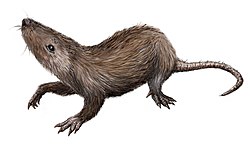| Bubodens | |
|---|---|
| Scientific classification | |
| Kingdom: | Animalia |
| Phylum: | Chordata |
| Class: | Mammalia |
| Order: | † Multituberculata |
| Suborder: | † Cimolodonta |
| Superfamily: | † Taeniolabidoidea |
| Genus: | † Bubodens Wilson, 1987 [1] |
| Species: | †B. magnus |
| Binomial name | |
| †Bubodens magnus Wilson, 1987 [2] | |
Bubodens magnus is a poorly understood, extinct multituberculate mammal from the Upper Cretaceous of South Dakota. It is known only from a single tooth, and has uncertain placement within the suborder Cimolodonta though has been tentatively argued to belong to Taeniolabidoidea. [3] Based on the dimensions of its molar, this species was estimated to have weighed around 5.25 kilograms (11.6 lb). [4]

